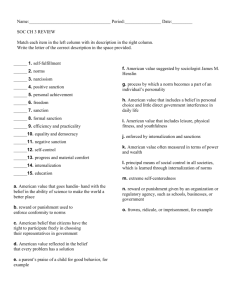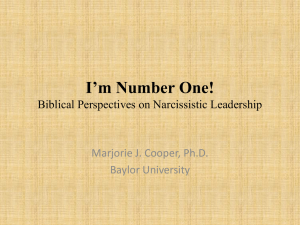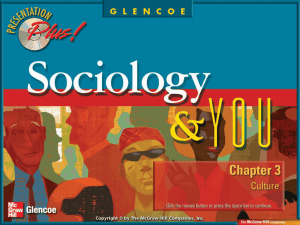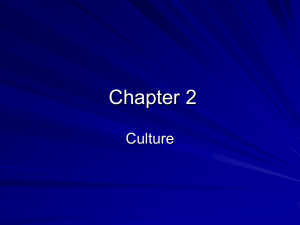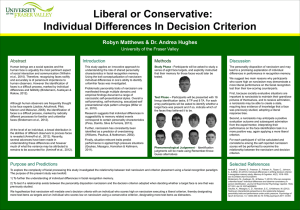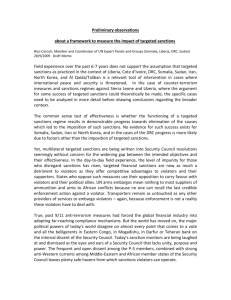Chapter 3 Notes
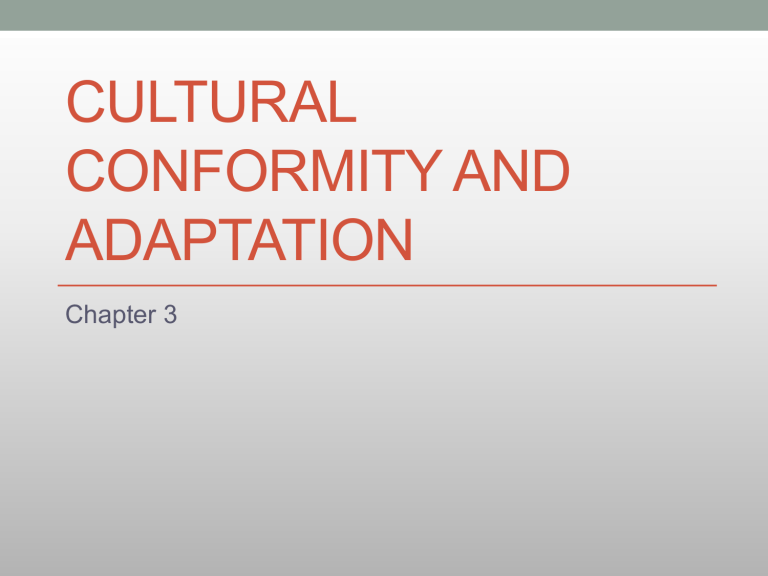
CULTURAL
CONFORMITY AND
ADAPTATION
Chapter 3
The Asch Conformity Experiment
• http://www.youtube.com/watch?v=iRh5qy09nNw&safety_ mode=true&persist_safety_mode=1&safe=active
• http://www.youtube.com/watch?v=QcmvbXgmdsU&featur e=related&safety_mode=true&persist_safety_mode=1&sa fe=active
Traditional American Values
• Identified by sociologist Robin
Williams in his study American
Society .
• A Set of 15 values that are central to the American way of life.
Personal Achievement
• Not surprisingly, most Americans value personal achievement.
• The U.S. was primarily built by people who believed in individualism and competition.
• Very evident in the area of employment, where achievement is often measured in terms of power and wealth.
Individualism
• For most Americans, individual effort is the key to personal achievement.
• Most people believe strongly in success through hard work and initiative.
• The downside is that most people feel that if a person does not succeed, they are to blame.
Work
• Most Americans value work, no matter what rewards are involved.
• Americans view discipline, dedication, and hard work as signs of virtue.
• We often view people who do not work as lazy or possibly immoral.
• Ex. welfare
Morality and Humanitarianism
• The U.S. was founded on strong religious faith, on a belief in justice and equality, and on charity towards those less fortunate.
• Most Americans place a high value on morality and tend to view the world in terms of right and wrong.
• Most Americans are quick to help those who are less fortunate or in trouble.
Efficiency and Practicality
• Americans tend to be practical and inventive people.
• We often solve problems using the most efficient technique for dealing with a situation.
• As a result of our problem solving ability, we tend to view new technology in terms of its usefulness and judge people on their ability to get things done.
Progress and Material Comfort
• Americans tend to believe that with hard work and determination our standard of living will continue to improve.
• We look to science and technology to continue to develop the material comforts that we strive for.
• Examples?
Equality and Democracy
• The United States was founded on the principle of human equality.
• To have human equality there must be equality of opportunity and an equal chance at success
.
• Even through equal opportunity, not everyone will be successful.
• Americans believe that citizens have the right to express their opinions and to participate in government.
Freedom
• Americans value personal freedoms of choice such as freedom of religion, speech, and press.
• Americans fight to protect these freedoms from direct government interference in their daily lives and business transactions.
Other Core Values
• Williams also identified other core values that help define American culture.
• Nationalism
• Patriotism
• Science and rationality
• Racial and group superiority
Education
• Sociologist James Henslin suggests that
Americans value education.
• Many Americans feel that people should achieve the highest level of education that his or her abilities will allow.
• Americans tend to look down on people who deliberately choose not to fulfill their educational potential.
• Do we look negatively on people who drop out?
Religion
• Henslin also feels that religion is a core
American value.
• Although we don’t expect people to belong to church, synagogue or mosque, we do expect people to live their lives according to basic religious principles.
Love
• Henslin also suggests that romantic love is another core American value.
• Americans strongly believe that people should marry primarily because they fall in love with each other.
• Do we see any flaws in this? Do we think that this might be changing in American society?
Assignment
•
Page 48
•
#’s 1, 3, 4a, and 4b
•
Turn in when finished
•
Due tomorrow
Our Changing Values
• Because our society is dynamic (always changing), some values change and new ones emerge.
• Researchers and sociologists have traced the development of several new values in the U.S.
• These values fall under the group of selffulfillment values
• Leisure
• Physical fitness
• youthfulness
Our Changing Values
• Self-fulfillment is a commitment to the full development of one’s personality, talents, and potential.
• Seminars, TV programs, and books offer people ideas on how to improve their personal and professional lives
.
Motivational Speakers…
•
http://www.hulu.com/watch/4183/s aturday-night-live-down-by-theriver
Problems
• According to some sociologists and researchers, this increased attitude of selffulfillment has led to another, unintended
American value…
Narcissism
Narcissism
• Christopher Lasch, Culture of
Narcissism
• Looks at the growing emphasis on personal fulfillment.
• Christopher Lasch feels that personal fulfillment may be a personality disorder.
• Narcissism: Extreme selfcenteredness
Narcissism
• Narcissistic personality disorder is a mental disorder in which people have an inflated sense of their own importance and a deep need for admiration. Those with narcissistic personality disorder believe that they're superior to others and have little regard for other people's feelings. But behind this mask of ultra-confidence lies a fragile selfesteem, vulnerable to the slightest criticism.
•
•
Narcissistic personality disorder is one of several types of personality disorders. Personality disorders are conditions in which people have traits that cause them to feel and behave in socially distressing ways, limiting their ability to function in relationships and in other areas of their life, such as work or school.
• Narcissistic personality disorder treatment is centered around psychotherapy.
(http://www.mayoclinic.com/health/narcissistic-personalitydisorder/DS00652)
Narcissism
• Sociologists feel that it weakens the established values of hard work and moderation.
• Some sociologists feel that Americans believe less in hard work than did earlier generations
(Yankelovich).
• Yankelovich viewed the development of selffulfillment as a beneficial change because it marked a movement away from satisfaction based on material gain.
Causes of Narcissism
• An oversensitive temperament at birth is the main symptomatic chronic form.
• Being praised for perceived exceptional looks or talents by adults.
• Excessive admiration that is never balanced with realistic feedback.
• Excessive praise for good behaviors or excessive criticism for poor behaviors in childhood.
Causes of Narcissism
• Overindulgence and overvaluation by parents.
• Severe emotional abuse in childhood.
• Unpredictable or unreliable caregiving from parents.
• Valued by parents as a means to regulate their own self-esteem.
Values… continued
• Concern for the environment (1990s)-
Growing support for environmental protection .
• 60% of Americans favor protecting the environment even at the expense of economic growth (according to a study done in the 90s).
How Values Change
• For long periods, the desire for progress took precedence over concerns for the environment.
• Ex. clearing forests, diverting river paths, building factories (pollution).
• Recently, it has become clear that some of these actions have damaged the environment,
• We need to find a balance between progress and conservation.
Advertising and Culture (Pg. 49)
• Top Ten Most Viral Super Bowl Ads of all time
• http://www.huffingtonpost.com/2013/02/01/viralads_n_2581579.html#slide=2042965
• http://www.businessinsider.com/the-20-most-viral-superbowl-ads-ever-2013-1?op=1
Advertising and Culture (Pg. 49)
• Advertisement #1
• http://www.youtube.com/watch?v=lL6JHB8oilI
• Advertisement #2
• http://www.youtube.com/watch?v=owGykVbfgUE&safety_ mode=true&safe=active&persist_safety_mode=1
• Advertisement #3 http://www.youtube.com/watch?v=5mFMiTcFdNQ&safety_ mode=true&persist_safety_mode=1&safe=active
• Advertisement #4 http://www.youtube.com/watch?v=nWqj6OQQOHA&safet y_mode=true&persist_safety_mode=1
Internalization of Norms
• When people come to believe that a particular norm is good, useful, and appropriate, they generally follow it and expect others to do the same.
• People have internalized the norm.
• Internalization is the process by which a norm becomes a part of an individual’s personality, thus conditioning that individual to conform to society’s expectations.
• Ex. Covering your mouth when you sneeze or cough.
• Stopping at a red light.
• You don’t do these things because you fear being punished, you do them because you have internalized society’s norms concerning sneezing and driving.
Sanctions
• Not everyone internalizes all of society’s norms.
• Some people must be motivated by sanctions; rewards or punishments used to enforce conformity to norms.
• Sanctions can be positive or negative.
Positive Sanctions
• An action that rewards a particular kind of behavior is a positive sanction.
• Most people are introduced to positive sanctions early in life through family interactions.
• Most parents praise their children for good behavior.
• Teachers react favorably to students who turn in good work, in the form of good grades.
Positive Sanctions
• Positive sanctions continue into adulthood as workers earn raises for good work.
• Cheers from the crowd or teammates push athletes to try even harder.
Negative Sanctions
• A punishment or the threat of punishment used to enforce conformity is a negative sanction.
• The threat of a punishment is often enough to ensure acceptable behavior.
• The threat of having your car towed maybe enough to not park in a “No Parking Zone .”
Negative Sanctions
• If the threat of punishment is not enough, the actual punishment is there to remind you that conformity is expected.
• Negative sanctions range from; frowns, ridicule, fines, imprisonment, even death.
• If you are rarely or never rewarded for good behavior nor punished for bad behavior, then sanctions quickly become meaningless to you.
Formal Sanctions
• In addition to positive or negative, sanctions can be formal or informal.
• A formal sanction is a reward or punishment given by a formal organization or regulatory agency.
• Ex. School, business, or government
• Negative formal: low grades, termination from job, imprisonment.
• Positive formal: Pay raises, promotions, awards and medals.
Informal Sanctions
• The majority of norms are enforced equally.
• An informal sanction is a spontaneous expression of approval or disapproval given by an individual or group.
• Ex. Standing ovations, smiles, compliments, pats on the back, gifts.
• Frowns, gossip, insults, ridicule, ostracism
(exclusion from a group).
• Informal sanctions are particularly effective among teenagers.
Social Control
• The enforcing of norms through either internal or external means.
• Self-control is the principle means of social control in societies.
• Self-control is learned through internalization of norms.
• Agents of self-control:
• Authority figures, police, the courts, religion, family, public opinion.
• When a society’s methods for ensuring conformity breakdown, social stability is lost.
Culture Change
• All cultures change over time, but cultures change at different rates.
• The more culture traits a culture has, the faster the culture can change since more possibilities for change exist.
• Change can be accelerated because each change brings about other changes.
• Ex. Automobiles- Not only changed transportation, but also provided employment, affected the way people shop, travel, where they live, what they do for leisure.
Values and Beliefs
• Since society is interrelated, changes in values and beliefs can be far reaching in society.
• An ideology is a system of beliefs or ideas that justifies the social, moral, religious, political, or economic interests held by a society.
• Ideologies are often spread through social movements.
Social Movements
• A social movement is a long term conscious effort to promote or prevent social changes.
• Social movements usually involve large numbers of people.
• Ex. Prohibition movement, women’s rights movements, peace movements, gay rights movements, civil rights movements, environmental movements.
Factors That Cause Social Change
•
Technology- Social change also occurs when people find new ways to manipulate their environment.
•
The knowledge and tools people use to manipulate their environment are called technology.
1. Technology
• 2 ways technology arises:
• DiscoveryRecognizing new uses for existing elements in the world or begin to understand them in new ways.
• Ex. Atomic fission, chewing gum and oil shale.
• InventionWhen people use existing knowledge to create something that did not previously exist,
• Can take the form of material objects, ideas, or patterns of behavior.
2. Population
• A change in population size may bring about changes in culture (food, economy).
• Population growth in the early 1900s.
• Economy: A growing population can increase the demand for goods and services, which can stimulate an economy.
• A community with declining population may need fewer jobs, which can limit employment needs.
Population
• Larger populations need more space, which affects the need for energy, food, housing, schools, stores, transportation, etc.
• People moving within a country may cause a loss of regional distinction.
• Average population age also creates social and cultural change.
3. Diffusion
• The process of spreading culture traits from one society to another.
• What is spread?
• Ideas, beliefs, and material objects are borrowed.
• The more contact a society has with another, the more it will borrow.
• Today, diffusion is constant with radio, internet, TV, telephone.
Diffusion
• Society tends to adopt material culture and technology more freely than ideas and beliefs.
• Reformulation: Adapting borrowed cultural traits.
• Diffusion is a 2 way process:
• Americans eat pasta, Mongolian BBQ, sushi
• American movies, music, cars, etc. are used throughout the world.
4. The Physical Environment
• The environment provides conditions that may encourage or discourage cultural change.
• Natural disasters such as droughts, floods, tsunamis, earthquakes, etc. can produce social and cultural change.
• People in some societies depend on foods that can be grown locally.
• Other societies must import their food or adapt new crops to their area.
The Physical Environment
• A change in supplies of natural resources may bring about cultural change (oil and gas prices from 1970s to today).
• Development of fuel efficient cars, once gas prices eased high-performance cars were produced again.
• What have the trends been over the last 5 years?
• Alternative forms of energy (wind power, alternative forms of fuel)
5. War and Conquests
• Wars can bring about the greatest change in the least amount of time.
• War causes changes in the economy as industry focuses on producing war materials rather than consumer goods.
• War can produce new technologies that can have civilian applications.
• War may also result in changes in government as new rulers come to power.
Resistance to Change
• Cultural change rarely occurs without some opposition.
• Social change often results from a compromise between opposing forces.
• Over time, people may accept a new idea that they strongly resisted at first.
• Other people may not accept, but they do learn to adapt.
Resistance to Change
•
What are the reasons people resist cultural change?
•
Ethnocentrism
•
Cultural lag
•
Vested interests
Ethnocentrism
• Change that comes from outside a society often meets with particularly strong resistance.
• People tend to believe that their own ideas and ways of doing things are best.
• Ex. “Buy American” campaign of the 1970s and 1980s.
• Hard to differentiate today between where foreign and domestic automobiles are produced.
Cultural Lag
• Some cultural traits change quickly, while others take considerable time.
• Cultural lag is a situation in which some aspects of the culture change less rapidly, or lag behind, other aspects of the same culture.
Cultural Lag
• Material culture usually changes quicker and non-material culture lags behind.
• School year and cultural lag
• 1800’s, school broke for summers so farming could begin.
• We don’t farm as much today, but we still have summers off. The traditional year stays.
Vested Interests
• People will usually take an imperfect present over an unknown future.
• People will also resist change that threatens their security or standard of living.
• Ex. Workers may oppose the introduction of new technology because they fear technology may replace them and cost them their jobs.
Vested Interests
• Entire industries have vested interests to protect.
• Oil companies benefitted from rising prices in the 1970s.
• It was difficult to pass permanent energy reforms because the oil industry lobbies the government to protect their industry and interests.

